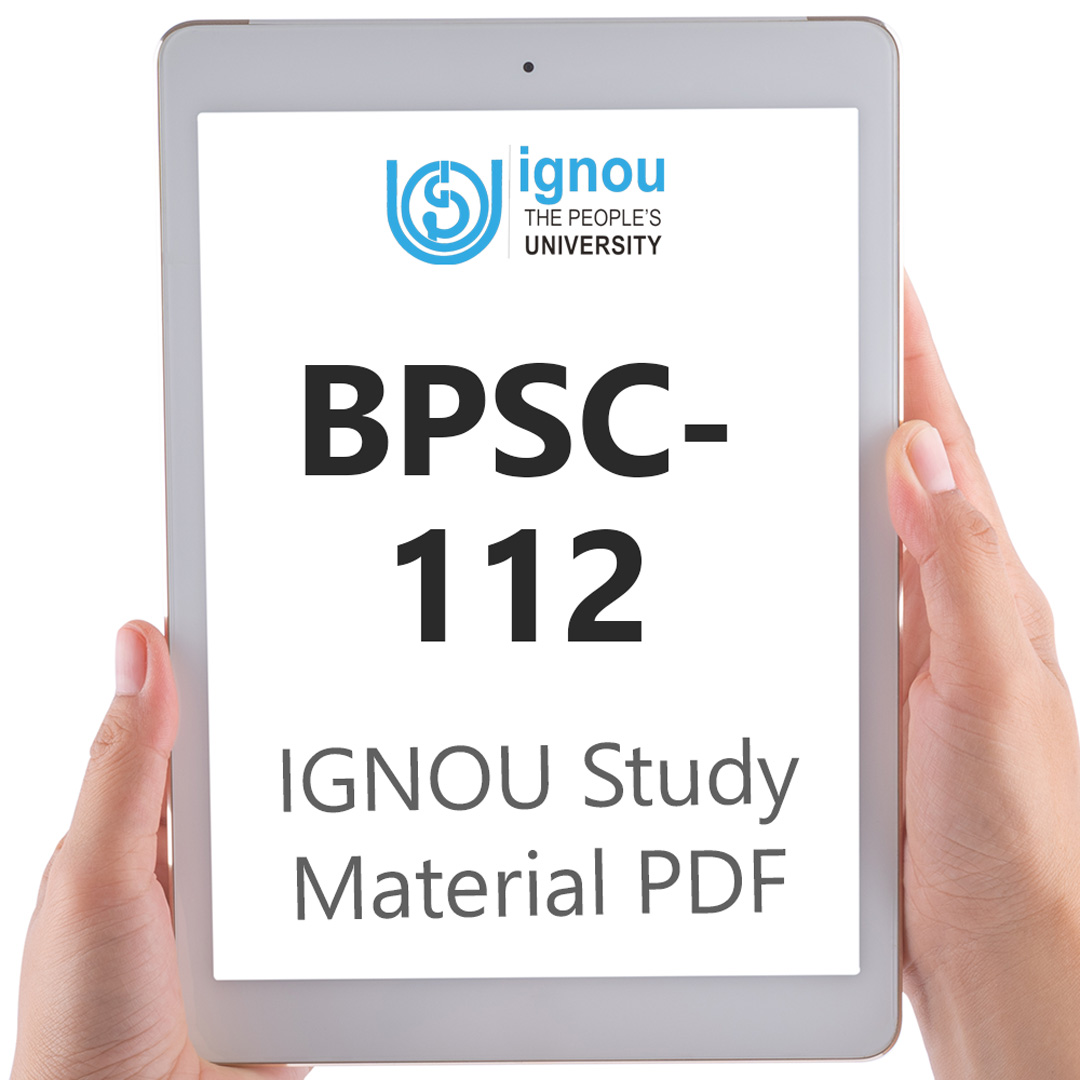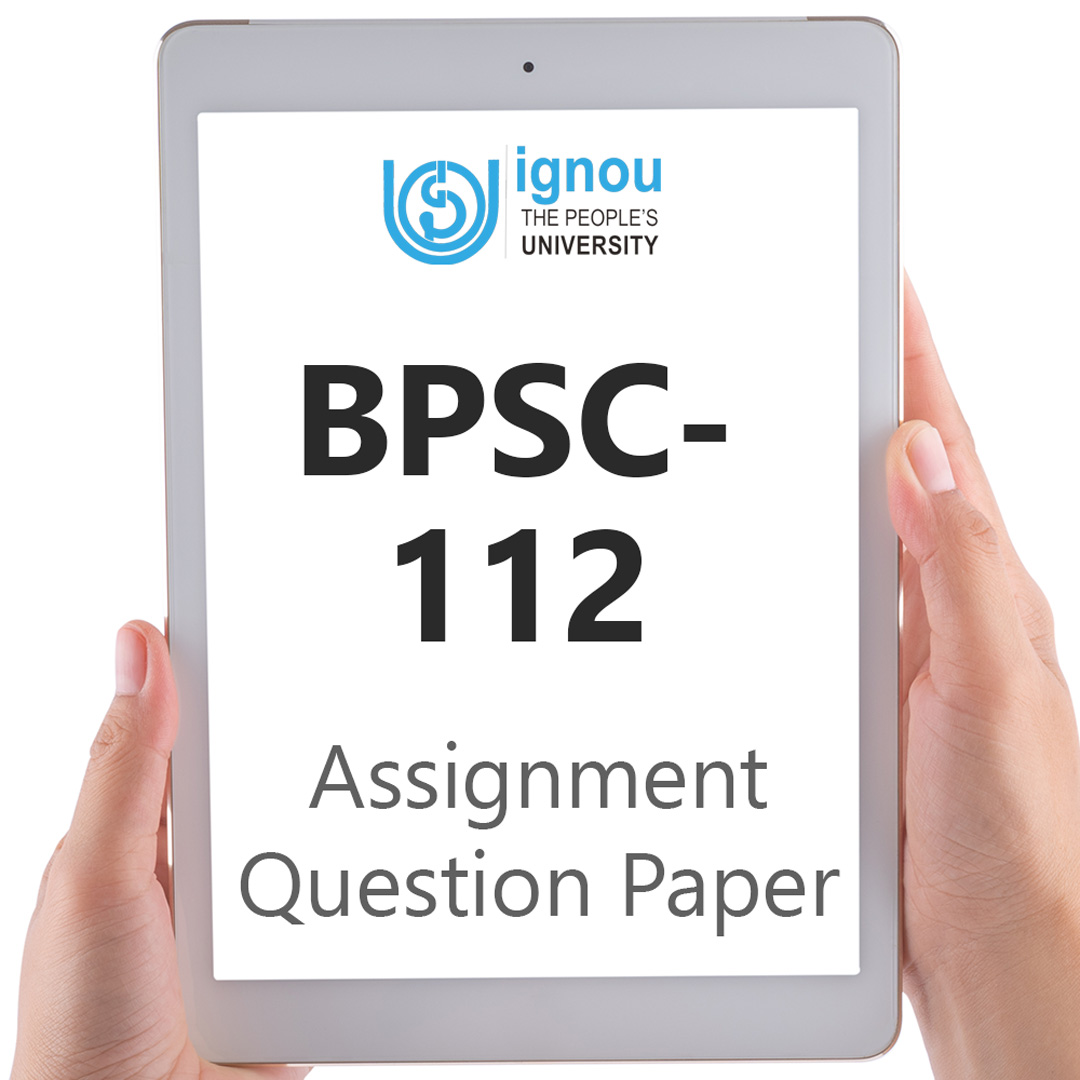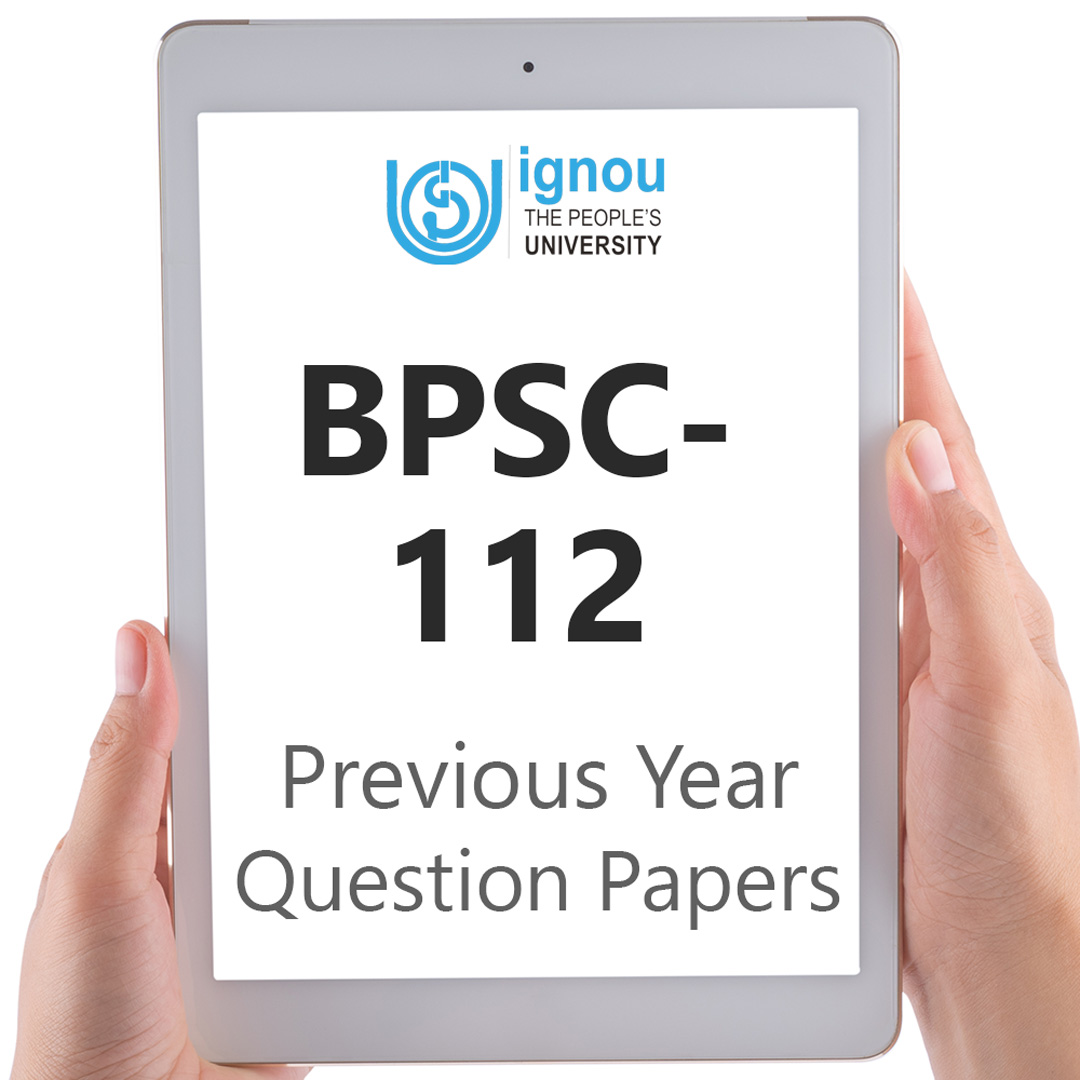If you are looking for BPSC-112 IGNOU Solved Assignment solution for the subject Indian Political Thought-I, you have come to the right place. BPSC-112 solution on this page applies to 2023-24 session students studying in BAPSH courses of IGNOU.
BPSC-112 Solved Assignment Solution by Gyaniversity
Assignment Code: BPSC-112/ASST/TMA/2023-24
Course Code: BPSC-112
Assignment Name: Indian Political Thought –I
Year: 2023-2024
Verification Status: Verified by Professor
Assignment - I
Answer the following in about 500 words each.
Q1) Elaborate upon the reactions towards the Brahmanic tradition.
Ans) The Brahmanic tradition, a term often associated with the Vedic and later Hindu religious and societal practices in ancient India, elicited varied reactions within Indian society and beyond. These responses evolved over centuries and across different social, religious, and philosophical groups.
a) Ancient and Medieval Period:
1) Acceptance and Endorsement:
The Brahmanic tradition, rooted in Vedic rituals, societal hierarchy (varna system), and sacrificial practices, found acceptance among the priestly class and the ruling elite. The Vedic texts and rituals were preserved and practiced by Brahmins, who held significant influence in religious affairs and society.
2) Criticism and Opposition:
Concurrently, there were dissenting voices. Certain ascetic movements, like the Shramana traditions (Buddhism and Jainism), emerged as reactions against Brahmanic rituals, caste rigidity, and the perceived exclusivity of Vedic practices. These traditions preached alternative paths to salvation and rejected the authority of the Vedas and Brahminical dominance.
b) Bhakti and Sufi Movements:
1) Bhakti Movement:
The Bhakti movement, starting around the 6th century CE, aimed to establish a direct, personal relationship with the divine, bypassing the rituals and intermediaries of the Brahmanic tradition. Bhakti saints composed devotional poetry in vernacular languages, emphasizing love, equality, and devotion to a personal deity.
2) Sufi Influence:
In addition, Sufism emerged as a response to the rigid hierarchy and ritualism that were inherent in the Brahmanic heritage within Islam. Saints of the Sufi tradition called for mystical experiences and direct communication with the divine, placing an emphasis on love and unity to all people everywhere.
c) Colonial and Modern Responses:
1) Colonial Perceptions:
During the colonial period, British colonialists, through orientalist perspectives, often viewed the Brahmanic tradition as representative of Indian culture. They sometimes romanticized or demonized it, depending on their interpretations. This contributed to the colonial portrayal of Indian society as backward or exotic.
2) Social Reform Movements:
The 19th-century social reform movements, led by figures like Raja Ram Mohan Roy and Dayananda Saraswati, critiqued certain aspects of the Brahmanic tradition. They advocated for social reforms, including the abolition of caste discrimination, women's rights, and the promotion of education.
d) Contemporary Context:
1) Continued Influence and Adaptations:
Even though it is constantly changing, the Brahmanic tradition continues to have a significant impact on Indian society. Various components of the Vedic heritage, including rituals, ceremonies, and other aspects, are still venerated, and practised. To accommodate contemporary sensitivities and shifting societal dynamics, however, there have been modifications and reinterpretations made to the original text.
2) Challenges and Critiques:
The Brahmanic tradition is the topic of constant arguments and criticisms in the current Indian environment. There are a number of problems that detractors bring up, including discrimination on the basis of caste, rigidity in religious traditions, and the need for improved social justice and inclusivity.
3) Revival and Rediscovery:
In addition, there is a resurgence of interest in the literature of the Vedas, yoga, and other spiritual activities that are associated with the Brahmanic heritage, not just in India but also all over the world. Some people and organisations are working toward the goal of re-discovering and reinterpreting historical traditions within contemporary circumstances.
In a nutshell, the responses to the Brahmanic tradition have been complex, ranging from acceptance and endorsement for the system to criticism and reform initiatives. It is true that the impact of the tradition has persisted throughout a variety of time periods; nevertheless, it has also been subjected to challenges and modifications in response to shifting societal, philosophical, and global circumstances.
Q2) Discuss the basic concepts of the Sramanic tradition.
Ans) The Sramanic tradition, originating in ancient India around the 6th century BCE, constitutes a diverse set of ascetic, philosophical, and religious movements. These traditions rejected certain aspects of the Brahmanic Vedic practices and emerged as alternative paths seeking liberation, focusing on ethical conduct, renunciation, and spiritual development.
Basic Concepts of Sramanic Tradition
a) Renunciation and Asceticism:
Sramanic traditions emphasize ascetic practices and renunciation of material possessions, aiming to detach from worldly desires and achieve spiritual liberation (moksha) or enlightenment. Ascetics practiced self-discipline, austerities, and celibacy in pursuit of spiritual goals.
b) Ethical Principles:
In Sramanic traditions, ethical behaviour is of the utmost importance. There are three fundamental principles: ahimsa, which means nonviolence; satya, which means truthfulness; and dharma, which means moral integrity. There is a strong emphasis placed on ethical living and compassion toward all living beings within these traditions.
c) Rejection of Vedic Rituals:
Sramanic movements differed from the rituals and practises of sacrifice that were found in the Brahmanic Vedic tradition. They advocated for a spiritual path that was more direct and personalised, and they opposed the intricate ritualism, the caste-based society, and the power of the Brahmin priesthood.
d) Diverse Philosophical Systems:
Sramanic traditions encompass various philosophical viewpoints. Jainism, propagated by Mahavira, emphasizes non-violence, karma theory, and the path of non-possession. Buddhism, founded by Siddhartha Gautama (Buddha), focuses on the Four Noble Truths, Eightfold Path, and cessation of suffering.
e) Focus on Meditation and Mindfulness:
Sramanic practises include meditation, mindfulness, and contemplative activities, all of which are essential components. Through the practise of these techniques, one hopes to cultivate self-awareness, achieve mental purity, and acquire a more profound comprehension of reality.
f) Rejecting the Caste System:
Sramanic traditions opposed the rigid caste hierarchy prevalent in ancient Indian society. They advocated for social equality and inclusivity, promoting the idea that spiritual attainment is accessible to all, irrespective of social status.
g) Emphasis on Liberation (Moksha):
Liberation from the cycle of birth and death (samsara) was a fundamental goal. Sramanic traditions sought to break free from the cycle of rebirth by following ethical conduct, self-discipline, and spiritual practices, aiming for ultimate liberation or enlightenment.
h) Teachings on Impermanence and Suffering:
These traditions highlighted the impermanent nature of existence and the universality of suffering. They emphasized the transient nature of material life and sought to transcend it through spiritual practices.
i) Propagation of Universal Truths:
In Sramanic traditions, there was a significant emphasis placed on the idea that spiritual truths are universally applicable. Rather than having unquestioning faith in theories, they pushed for the significance of individuals having their own personal experiences and having an understanding of the world around them.
j) Diversity and Evolution:
A vast range of Sramanic traditions existed, and throughout the course of time, they evolved into their current form. Over the course of the tradition's history, other minor sects, such as Jainism and Buddhism, have developed their own unique ideologies, rituals, and interpretations of the heritage.
The Sramanic tradition, while originating as a reaction to certain aspects of the Brahmanic tradition, has profoundly influenced Indian religious and philosophical thought. It propagated ethical principles, meditation practices, and philosophies centered on liberation and non-violence, contributing significantly to the spiritual and cultural landscape of ancient India and beyond.
Assignment - II
Answer the following questions in about 250 words each.
Q1) Compare the Islamic traditions in Indian thought with the Brahmanic tradition.
Ans) Comparison Between Islamic Traditions in Indian Thought with and Brahmanic Tradition:
Q2) Write a note on the means of reforms in the era of Bhakti tradition.
Ans) The Bhakti movement, which emerged in medieval India between the 7th and 17th centuries, sought religious and social reforms through devotion and personal spiritual experiences. It aimed to democratize spirituality and challenge the hierarchical and ritualistic aspects of established religious practices prevalent during that era.
Means of Reforms in the Bhakti Tradition
a) Devotional Poetry and Vernacular Languages:
Bhakti saints composed devotional songs and poetry in regional languages, making spiritual teachings accessible to the masses. This approach bypassed the exclusive use of Sanskrit, which was limited to the educated elite, and propagated spiritual messages directly to the common people.
b) Emphasis on Personal Experience and Love for the Divine:
The Bhakti movement emphasized a direct, personal connection with the divine. It advocated love and devotion (bhakti) as the means to attain spiritual liberation, shifting the focus from elaborate rituals and priestly intermediaries to individual devotion and sincerity.
c) Social Equality and Inclusivity:
Bhakti saints advocated for social equality, rejecting caste-based discrimination, and emphasizing the spiritual equality of all individuals. They welcomed people from all castes and backgrounds into their fold, disregarding societal hierarchies.
d) Critique of Ritualism and Priestly Authority:
The movement criticized the complex rituals and priestly authority prevalent in the orthodox religious structures of the time. Bhakti saints highlighted the importance of inner devotion over external rituals, challenging the established religious norms.
e) Women's Participation and Empowerment:
Bhakti saints welcomed women as active participants and devotees, providing them a platform for spiritual expression and emancipation. This inclusion challenged the prevailing norms of women's exclusion from religious practices.
f) Community Gatherings and Satsang:
Bhakti saints organized congregational gatherings (satsangs) where people from various backgrounds congregated to sing devotional songs, discuss spiritual teachings, and share experiences. These gatherings fostered a sense of community and solidarity.
g) Propagation through Oral Tradition:
The teachings of Bhakti saints were disseminated primarily through oral traditions, storytelling, and songs. This approach facilitated the spread of their messages among the illiterate masses and contributed to the preservation of their teachings.
The Bhakti movement's emphasis on love, devotion, inclusivity, and direct connection with the divine significantly influenced Indian society and religion. Its reformative means challenged the existing religious orthodoxy, fostering a more inclusive and personal approach to spirituality, and leaving a lasting impact on Indian religious and social ethos.
Q3) Elaborate upon Justice and Dandniti as expounded in the ‘Mahabharat’.
Ans) In the Indian epic Mahabharata, the concepts of justice (dharma) and governance (dandniti) play pivotal roles in the narrative, offering profound insights into moral, ethical, and administrative principles.
Justice (Dharma) in Mahabharata
a) Ethical and Moral Code: Dharma in the Mahabharata encompasses righteousness, ethical conduct, duty, and cosmic order. It delineates the moral principles governing human behaviour, stressing adherence to one's duty (svadharma) in various roles in society.
b) Diverse Interpretations: The epic explores the complexities of dharma through various characters, each embodying differing perspectives. It raises dilemmas and moral quandaries, highlighting the conflict between personal ethics and societal obligations.
c) Role in Decision-Making: The characters grapple with ethical dilemmas, prompting debates on what constitutes righteous action. Dharma guides the choices made by individuals and the consequences of their actions, emphasizing the importance of ethical conduct and responsibility.
Governance (Dandniti) in Mahabharata
a) Administrative Principles: Dandniti refers to the principles of governance, justice, and administration. It elucidates the guidelines for rulers and administrators in maintaining law and order and ensuring justice in society.
b) Role of the King: The Mahabharata delineates the duties of a king (rajadharma) and emphasizes the ruler's responsibility in upholding dharma and dispensing justice impartially.
c) Balance between Justice and Punishment: Dandniti emphasizes the importance of balanced justice. It illustrates the need for fair punishment while cautioning against excessive severity or leniency, emphasizing the concept of just retribution.
d) Guidelines for Effective Rule: The epic offers insights into good governance, advocating for principles that ensure the welfare of the subjects, equitable distribution of resources, and protection of individual rights.
e) Conflict and Resolution: The narrative showcases instances where dandniti is challenged by conflicting interests, prompting debates on the appropriate course of action. These conflicts underscore the complexity of justice and governance in real-world scenarios.
In essence, the Mahabharata's portrayal of dharma and dandniti reflects the multifaceted nature of justice and governance. It serves as a repository of ethical dilemmas, offering nuanced perspectives on moral conduct and administrative principles, presenting a complex tapestry of moral and ethical principles that continue to resonate in contemporary discourses on justice and governance.
Assignment - III
Answer the following questions in about 100 words each.
Q1) What is ‘Rajdharma’? Explain.
Ans) When referring to the ethical duties and responsibilities that are incumbent upon a ruler or monarch, the term "Rajdharma" is used. It includes the guiding ideas and requirements that a monarch must adhere to in order to govern in a manner that is both just and responsible. Rajdharma places an emphasis on the responsibility of the ruler to enforce justice, protect the welfare of the people, maintain law, and order, and ensure the well-being of the kingdom. The essence of good governance and the moral responsibilities that are imposed upon a ruler in ancient Indian socio-political traditions are embodied in this concept, which comprises adhering to virtuous conduct, making ethical decisions, and pursuing the welfare of the subjects.
Q2) Discuss the coercive power of the state.
Ans) The coercive power of the state is the authority vested in it to employ force or the threat of force to uphold law, maintain order, and ensure compliance with regulations. It includes the use of physical force by institutions like the police, military, and judiciary to enforce laws, protect citizens, and deter crime. This power allows the state to exercise control over its territory, managing internal and external threats, and safeguarding the welfare of society. The legitimacy of this power is crucial, ensuring it is used within legal frameworks and ethical boundaries to maintain social stability and protect citizens' rights.
Q3) Trace the idea of ‘Chakravartin’ and the state as an instrument of Dhamma.
Ans) The concept of 'Chakravartin' originates from ancient Indian political thought, signifying a universal monarch or ideal ruler. A Chakravartin is one who conquers the entire world and upholds righteous governance. In Buddhist tradition, a Chakravartin is associated with the idea of a righteous king who rules according to Dhamma, promoting moral principles and welfare. The state, in this context, becomes an instrument of Dhamma, emphasizing ethical governance, social justice, and the well-being of the subjects. This concept underscores the ideal that political authority should be exercised with a commitment to moral values and the greater welfare of society.
Q4) Write a note on the notion and symbols of sovereignty.
Ans) The term "sovereignty" refers to the supreme authority and autonomy that a state possesses over its geographic region, its population, and its governance without intervention from outside sources. The exclusive authority of the state to enact and enforce laws, exercise control over resources, and manage international affairs is embodied in this concept. Some examples of symbols of sovereignty include flags, national anthems, seals, and emblems. These symbols are used to signify the identity and authority of a state. Their purpose is to provide as visual and symbolic symbols of the nation's unity, values, history, and the autonomy it possesses. Among the populace, these symbols inspire feelings of patriotism, loyalty, and a sense of belonging, which in turn helps to strengthen the power of the state and cultivate a sense of collective identity.
Q5) Examine Abul Fazal’s methodology.
Ans) In the process of creating Akbarnama and Ain-i-Akbari, Abul Fazl, a Mughal courtier, and chronicler who lived during Akbar's reign, utilised a system that was both exhaustive and meticulous. His methods included conducting interviews, conducting empirical research, and conducting critical analysis. Fazl conducted significant research and verification of historical material by conducting interviews with academics, courtiers, and eyewitnesses to guarantee that the information was accurate. Through his writings, he incorporated a variety of viewpoints, cultural insights, and administrative particulars. Fazl's work is notable for its systematic approach, factual precision, and incorporation of social, cultural, and economic aspects of Akbar's empire. As a result, it establishes a new standard for historical documentation during that time period.






